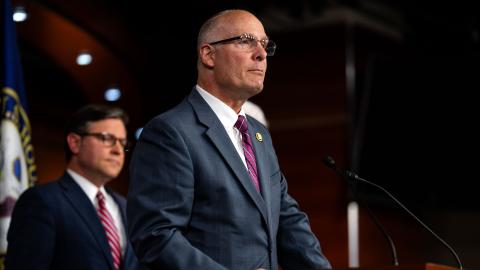A new report, cited in various media outlets, claims that repealing Obamacare would "cost roughly $350 billion" over a decade and "leave no funds available for 'replacement' legislation." In truth, repealing Obamacare and replacing it with a good conservative alternative would cut federal spending by at least $1 trillion over a decade, and probably more. Only in Washington could repealing a huge federal program with a 10-year price tag of roughly $2 trillion be described as bringing about a "cost" increase.
The report in question was released by the Committee for a Responsible Federal Budget (CRFB). It essentially parrots the projections of the Congressional Budget Office—the CRFB writes that its estimates "are based primarily" on three CBO reports—which have been wrong about Obamacare's coverage numbers and costs at nearly every turn. (For example, the CBO originally said Obamacare would lead to 15 million more people having private health insurance as of 2017 (23 million in the exchanges minus 8 million who lost other private plans), while it now says that tally is only 9 million (15 million in the exchanges minus 6 million who lost other private plans)—just 60 percent of the original projection.)
The most misleading aspect of the CRFB report is that it uses "cost" to refer not to spending, but rather to net budgetary effects. So if federal spending increases by a huge amount but taxes increase by even more, that doesn't "cost" anything—at least according to the report. But when most people think of something's "cost," they sensibly think of how much one would have to spend to buy it. In that vein, the report notes that $2 trillion will be spent on Obamacare's subsidies and its Medicaid expansion between now and 2027.
Compare that with a good conservative alternative to Obamacare, like the legislation (which has 84 cosponsors) introduced by Dr. Tom Price, President-elect Trump's nominee for secretary of Health and Human Services—or the House Republican leadership's "Better Way" proposal, which is mostly consistent with Price's legislation. The Center for Health and Economy (H&E) scored the alternative on which the Price legislation is largely based (I released that plan at the 2017 Project and have advanced it at the Hudson Institute) and found it would cost $1.13 trillion less than Obamacare over eight years (while substantially lowering premiums and increasing the number of people with private health insurance by 6 million).
Even that scoring likely underestimates the reduction in federal spending involved. More than half of the gross budgetary "cost" of such a conservative alternative would likely come from tax cuts, whereas essentially all of Obamacare's roughly $2 trillion gross budgetary "cost" comes from spending. So such an alternative would reduce federal spending by even more than $1.13 trillion over eight years.
That's because a good Republican alternative would give overdue tax cuts to millions of middle-class Americans—who unfairly don't get a tax break for health insurance like their neighbors with job-based insurance—whereas Obamacare's direct subsidies to insurance companies don't cut anyone's taxes. They are pure spending (contrary to the CBO's falsely labeling some $104 billion worth of such spending as tax cuts).
The CBO has generally refused to provide tallies for federal spending in its Obamacare projections, lumping tax cuts and spending outlays together under the broad heading of "costs," and the CRFB report follows suit. The CBO should be made to provide clear tallies for federal spending when it scores repeal-and-replacement legislation. And that spending score should be a key criterion on which any alternative is judged.
To be sure, there are some Republicans who want to pass an alternative that spends nearly as much (or every bit as much) as Obamacare; that provides direct subsidies to insurance companies instead of tax credits to individuals and families; and that even lets the government "auto-enroll" Americans in insurance they didn't choose, sending taxpayers' money to insurers to cover the bills for these unrequested plans. But a good—and conservative—alternative to Obamacare would cut federal spending by more than $1 trillion, and it would cut taxes even versus the pre-Obamacare status quo.
While the press corps has focused mostly on the CRFB report's dubious claim of "cost" increases, here are four other key claims the report makes—all of which make repeal look quite attractive:
# Repealing Obamacare's direct outlays to insurance companies ($900 billion) and its Medicaid expansion ($1.1 trillion) would save $2 trillion in federal spending over a decade.
# Repealing Obamacare's "coverage and revenue provisions"—basically its spending and taxes—would reduce deficits by $950 billion on a dynamic basis over a decade ($750 on a static basis).
# Repealing Obamacare would increase deficits only if its Medicare raid ($1.1 billion) were repealed—whereas even if, say, half of the Medicare raid were stopped, the result would be a $400 billion budgetary surplus ($950 billion from repealing Obamacare's spending and taxes, minus $550 billion from stopping half of Obamacare's Medicare raid).
# Repealing Obamacare would "likely increase the size of the economy by about 0.5 to 1 percent by the end of the decade." And since the CBO says the GDP will be about $28 trillion at that time, a 1 percent increase would be about $280 billion, or about $800 per American—just from repeal.
The claim that a massive new federal entitlement program like Obamacare would decrease deficits has always been laughable—and the American public has always found it to be unbelievable. (For a quick review of Obamacare's Fantasyland budgetary claims, see Paul Ryan's takedown of President Obama at the 2010 "health summit.")
In sum, repealing and replacing Obamacare with a good conservative alternative would save 13 digits' worth of federal spending. It would also restore liberty and revive a health insurance market that the federal government has ruined.


















